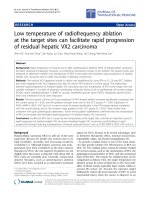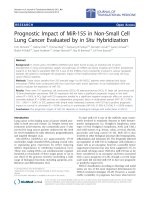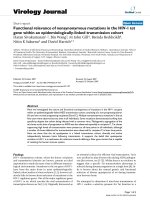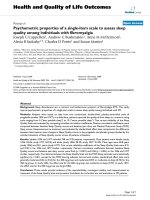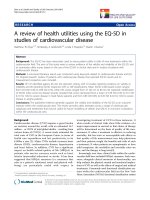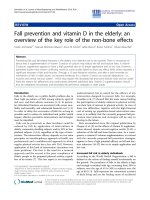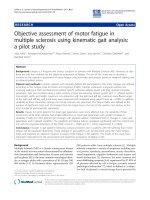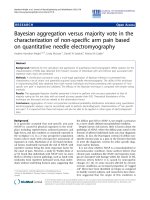Báo cáo hóa học: " Functional relevance of nonsynonymous mutations in the HIV-1 tat gene within an epidemiologically-linked transmission cohort" pot
Bạn đang xem bản rút gọn của tài liệu. Xem và tải ngay bản đầy đủ của tài liệu tại đây (288.46 KB, 5 trang )
BioMed Central
Page 1 of 5
(page number not for citation purposes)
Virology Journal
Open Access
Short report
Functional relevance of nonsynonymous mutations in the HIV-1 tat
gene within an epidemiologically-linked transmission cohort
Haran Sivakumaran
1,2
, Bin Wang
3
, M John Gill
4
, Brenda Beckholdt
4
,
Nitin K Saksena
3
and David Harrich*
1
Address:
1
Division of Infectious Diseases and Immunology, Queensland Institute of Medical Research, Brisbane, Queensland, Australia,
2
School
of Population Health, The University of Queensland, Brisbane, Queensland, Australia,
3
Retroviral Genetics Group, Centre for Virus Research,
Westmead Millennium Institute, Westmead Hospital, The University of Sydney, Westmead, New South Wales, Australia and
4
Department of
Medicine, University of Calgary, N.W. Calgary, Alberta, Canada
Email: Haran Sivakumaran - ; Bin Wang - ; M
John Gill - ; Brenda Beckholdt - ;
Nitin K Saksena - ; David Harrich* -
* Corresponding author
Abstract
Here we investigated the nature and functional consequences of mutations in the HIV-1 tat gene
within an epidemiologically-linked AIDS transmission cohort consisting of a non-progressing donor
(A) and two normal progressing recipients (B and C). Multiple nonsynonymous mutations in the tat
first exon were observed across time in all individuals. Some mutations demonstrated striking host
specificity despite the cohort being infected with a common virus. Phylogenetic segregation of the
tat clones at the time of progression to AIDS was also observed especially in recipient C. Tat clones
supporting high levels of transactivation were present at all time points in all individuals, although
a number of clones defective for transactivation were observed for recipient C in later time points.
Here we show that the tat quasispecies in a linked transmission cohort diversify and evolve
independently between hosts following transmission. It supports the belief that quasispecies
variation in HIV-1 is a mechanism for selection towards defining a fitter gene variant that is capable
of resisting the human immune system.
Findings
HIV-1 transmission cohorts, where the donor, recipients
and transmission histories are known, present an ideal
opportunity to study the same virus in different immuno-
logical environments. Mutations in the env gene of HIV-1
have been the main focus in most epidemiologically-
linked cohort studies of virus evolution [1,2], however rel-
atively little in known about selection of mutations in the
HIV-1 regulatory genes. One of the major regulatory genes
of HIV-1 is tat, which encodes the viral transactivator of
transcription known as Tat [3,4]. Originally discovered as
an essential cofactor for efficient viral transcription, Tat is
now ascribed to play diverse roles during AIDS pathogen-
esis [for reviews, see [5-7]]. Whilst there is no evidence to
suggest that a specific Tat transactivation phenotype is
selected during disease progression in a single host [8], lit-
tle is known about the natural genetic and functional
selection of diverse quasispecies of tat during transmis-
sion between hosts.
We attempted to determine if inter-host transmission of
HIV-1 confers a selective pressure for Tat function in a
Published: 25 October 2007
Virology Journal 2007, 4:107 doi:10.1186/1743-422X-4-107
Received: 24 August 2007
Accepted: 25 October 2007
This article is available from: />© 2007 Sivakumaran et al; licensee BioMed Central Ltd.
This is an Open Access article distributed under the terms of the Creative Commons Attribution License ( />),
which permits unrestricted use, distribution, and reproduction in any medium, provided the original work is properly cited.
Virology Journal 2007, 4:107 />Page 2 of 5
(page number not for citation purposes)
unique epidemiologically-linked cohort of three individ-
uals [1,9]. The cohort consisted of a long-term non-pro-
gressor (donor A) who transmitted HIV-1 to two
recipients (B and C) via blood transfusion. The recipients
subsequently developed AIDS and progressed normally,
with recipient C recently dying from an AIDS-related ill-
ness following rapid progression around the time of
death. Infected peripheral blood mononuclear cells
(PBMCs) were collected from the individuals at various
time points and the integrated first-exon tat sequences
were amplified from these cells.
Multiple first-exon tat sequences were amplified by nested
PCR from the PBMCs of the cohort members at 5 time
points from donor A, 4 time points from recipient B and
12 time points from recipient C. (Refer to additional file
1: detailed methods.) These amplicons were subsequently
cloned into expression vectors and a total of 89 tat clones
were generated. Twenty-six unique clones were identified
after comparison of amino acid sequences ([Gen-
Bank:EU184659
] – [GenBank:EU184684]). These unique
clones were aligned against the most prevalent clone from
donor A (clone A1-1), which revealed the presence of
multiple amino acid substitutions in all individuals
(Figure1). Host-specific mutations are highlighted by
solid boxes in Figure 1 whereas mutations common
between hosts are marked with dashed boxes. Attestation
of these changes was also visualised using phylogenetic
reconstruction of the tat clones using both nucleotide and
peptide sequences. The nucleotide (Figure 2A) and pep-
Amino acid alignment of cohort Tat clonesFigure 1
Amino acid alignment of cohort Tat clones. The sequenced cohort Tat clones are aligned against clone A1-1. A dot rep-
resents amino acid identity at that position; an asterisk represents a stop codon. Tat domains as described by [19] are sepa-
rated by vertical lines, individual-specific substitutions are indicated by solid boxes and substitutions common to recipients B
and C by dashed boxes. The amino acid sequence of one-exon Tat from HIV-1 clone SF2 is shown for comparison. The nucle-
otide sequences of these clones are available from GenBank ([GenBank:EU184659
] – [GenBank:EU184684]).
Virology Journal 2007, 4:107 />Page 3 of 5
(page number not for citation purposes)
tide (Figure 2B) topologies were distinct suggesting that
the nonsynonymous changes in the tat genes may have
some bearing on the genetic relationship between tat
clones from a single individual and may carry functional
relevance, as confirmed herein.
Tat proteins from the donor A clones were generally com-
prised of previously observed amino acid residues as
described in the Los Alamos HIV Sequence Database
[10,11]. Residues in the donor A clones considered infre-
quent or rare were E12, L32, and R66, as well as residues
H59 and D68, which were both common to all donor A
clones. The D68 residue has not been previously
described and was not observed in Tat clones of recipients
B or C, which possessed the commonly found S68 or P68
residues. Recipient B's host-specific mutations (compared
to clone A1-1) were T39I, R40S and D68S. Recipient C's
host-specific mutations, in contrast, were R19S, A21P,
Y47H (except clone C3-3), D68P and S70P (except clones
C1-1 and C2-5). The substitutions H59P and A67V were
seen in all clones from recipients B and C (dashed boxes
in Figure 1) but not in any of the clones from donor A.
Thus distinct nonsynonymous mutations were observed
in the Tat clones from all cohort members that segregated
in a host-specific manner as well as two mutations that
showed common specificity to the transmission recipi-
ents. The specificity of these mutations are consistent with
host-driven evolution of the tat quasispecies in each
cohort member.
There were considerable differences in sequence diversity
between Tat clones from the donor and the two recipients.
Donor A clones showed less diversity in amino acid
sequences compared to the recipients, whereas recipient B
clones were less diverse than clones from recipient C.
Interestingly, none of the amino acid mutations identified
in the donor were observed in either of the recipients, who
share more nonsynonymous mutations between them
compared to their common donor.
Further, demonstration of these host-specific differences
in viral quasispecies is depicted in Figure 3A, which shows
the scoring of the different Tat amino acid sequences in
the tat quasispecies over time. Figure 3A depicts each time
point as stacked columns representing the composition of
the tat quasispecies based on amino acid sequence. For
example, time point A5 shows that three of five sequenced
Tat clones were identical to clone A1-1 with the remaining
two clones identified as clones A5-4 and A5-5. The data
identify dominant tat clones present in all three individu-
als: clone A1-1 for donor A, clone B2-1 for recipient B and
clones C1-2 and C2-4 for recipient C. These clones were
present in most of the time points (or all of the time
points for donor A) within the respective individual but
were not seen in any other individual. Overall, despite dif-
ferences in HIV-1 genetic variability in each member of
the cohort, there was considerable stability in the quality
of mutations over time in each individual.
The transactivation abilities of each individual's unique
Tat clones were assessed using a luciferase reporter assay.
The luciferase reporter contains the HIV-1 LTR upstream
of the luc gene meaning that specific binding of Tat to an
RNA structure (the transactivation response element, or
TAR) in the LTR drives powerful expression of luciferase.
Only the protein expressed from the first exon of tat is
required to fully transactivate the LTR [12], thus we tested
the first exons of the tat clones in the assay. The transacti-
vated luciferase output of each one-exon tat clone are rep-
resented in Figure 3B as fold activation over a control one-
exon tat gene from the SF2 isolate of HIV-1. Transfection
efficiencies were normalised with a β-galactosidase
expression plasmid. This accounts for variations in plas-
mid amounts but not, however, for variations in Tat clone
expression levels or protein stability. Clones from donor
A demonstrated two- to three-fold transactivation over
SF2 Tat with all but clone A5-4 showing no significant dif-
ference (p > 0.01) compared to clone A1-1. Similarly for
recipient B, all but clone B3-2 showed no difference in
transactivation compared to A1-1. The low values for A5-
4 and B3-2 are attributable to substitutions in the
cysteine-rich domain of Tat (F32L and K28E, respec-
tively), a critical region for transactivation and intramo-
lecular bonding [13,14].
Phylogenetic analysisFigure 2
Phylogenetic analysis. Neighbour-joining phylogenetic
reconstruction of tat clones based on nucleotide (A) and
peptide (B) sequences. The differences in the tree topologies
suggest nonsynonymous evolution of tat in each host. Donor
A's clone A1-1 is underlined in both cladograms.
C11-4
C10-1
C12-1
C3-3
C11-5
C11-2
C1-4
C1-2
C7-1
C2-3
C2-4
C3-2
C1-1
C2-5
A1-1
A5-5
A6-5
A5-4
A6-4
B3-5
B2-1
B3-2
B3-1
B3-3
C11-4
C10-1
C12-1
C3-3
C11-5
C11-2
C1-4
C1-2
C7-1
C2-3
C2-4
C3-2
C1-1
C2-5
A1-1
A5-5
A6-5
A5-4
A6-4
B3-5
B2-1
B3-2
B3-1
B3-3
C1-2
C7-1
C12-1
C11-5
C11-2
C2-3
C2-4
C3-2
C1-1
C2-5
A1-1
A5-4
A6-5
A5-5
A6-4
B3-3
B2-1
B3-2
B3-5
B3-1
C1-4
C3-3
C10-1
C11-4
C1-2
C7-1
C12-1
C11-5
C11-2
C2-3
C2-4
C3-2
C1-1
C2-5
A1-1
A5-4
A6-5
A5-5
A6-4
B3-3
B2-1
B3-2
B3-5
B3-1
C1-4
C3-3
C10-1
C11-4
AB
Virology Journal 2007, 4:107 />Page 4 of 5
(page number not for citation purposes)
The Tat clones from recipient C possessed the widest
diversity of transactivation function. Twelve of the sixteen
unique clones showed significantly less (p < 0.01) transac-
tivation abilities compared to A1-1 (denoted by asterisks
in Figure 3B). The general attenuation seen in all of recip-
ient C's Tat clones is most likely due to two mutations,
Y47H and R52W, located in the highly conserved core and
basic domains (respectively) of Tat. The core domain
mutation has been reported to suppress but not eliminate
transactivation ability [15-17], and R52 participates in the
binding of Tat to TAR and is involved in the nuclear local-
isation of Tat [18,19]. The strong or total suppression of
transactivation abilities observed in many of the recipient
C clones is due to various mutations in the cysteine-rich
and core domains or, in the case of clones C3-1 and C7-5,
due to premature stop codons (Figure 1).
It is interesting, and apparently paradoxical, to note that
many of the defective Tat clones in recipient C appeared at
later time points around the time of rapid progression. It
is possible that loss of viral transactivation ability may be
required for rapid disease progression in this particular
individual. Alternatively, the detection of inactive tat
mutants could have been enhanced through the sampling
of tat genes from lower amounts of PBMCs at these later
time points, especially CD4
+
T cells and other HIV-1 reser-
voirs (see additional file 2: cohort data). However it
should be stressed that fully active Tat could consistently
be detected in recipient C at nearly all time points and that
these defective Tat mutants were not dominant in the qua-
sispecies population (Figure 3A). In general our results
suggest that the majority of Tat clones from donor A and
recipients B and C activated the HIV-LTR similarly to
donor A's clone A1-1, whilst most of the latter time-point
clones from recipient C were attenuated.
The evidence presented here demonstrate the selection of
multiple nonsynonymous mutations in tat in a unique
epidemiologically-linked cohort following transmission
of HIV-1. Comparisons of the relative transactivation abil-
ities of the Tat clones indicated that the donor and recipi-
ents had signature tat genes that conferred strong
transactivation potential. While these experiments do not
link a tat transactivation mutation to disease progression,
it remains possible that alternative Tat functions may con-
tribute to disease progression and that these may be sub-
ject to selective pressures during transmission
independent of transactivation function. Quasispecies
modulation in vivo is vital to the survival of HIV-1 as well
as the functional selection of a dominant variant that is
capable of counteracting neutralisation by the host
immune system.
Competing interests
The author(s) declare that they have no competing inter-
ests.
Authors' contributions
HS and BW performed the experiments. BB and MJG pro-
vided the samples from the cohort. NKS and DH super-
vised the project, and all authors contributed to the text.
Composition, variation, and activity of the cohort's tat qua-sispecies over timeFigure 3
Composition, variation, and activity of the cohort's
tat quasispecies over time. (A) Multiple one-exon tat
clones from donor A, recipient B and recipient C were
sequenced and their amino acid sequences were compared at
each time point (represented as columns). Identical amino
acid sequences were classed together as clones and are rep-
resented above as boxes within the columns. The numbers
within the columns indicate the total number of tat clones
successfully sequenced for each time point. See Figure 1 for
the clones' amino acid sequences. (B) Relative transactivation
abilities of the cohort tat clones. Columns are transactivated
luciferase output normalised against constitutive β-galactosi-
dase output and expressed relative to a positive control for
transactivation (the SF2 clone of one-exon tat). The values at
the bases of the columns indicate the number of times that
particular Tat amino acid sequence was scored in the entire
sample set. An asterisk indicates p < 0.01 for the null hypoth-
esis compared to clone A1-1. Results are means and stand-
ard deviations of three independent experiments.
Donor A
A1 A3 A4 A5 A6
A1-1
A5-4
A5-5
A6-4
A6-5
Recipient B
B2 B3 B5 B6
B2-1
B3-1
B3-2
B3-3
B3-5
Recipient C
C1 C2 C3 C4 C5 C6 C7 C8 C9 C10 C11 C12
C1-1 C1-2
C1-4 C2-3
C2-4 C2-5
C3-1 C3-2
C3-3 C7-1
C7-5 C10-1
C11-2 C11-4
C11-5 C12-1
Donor A
0
1
2
3
A1-1 A5-4 A5-5 A6-4 A6-5 SF2 no Ta t
Recipient B
0
1
2
3
B2-1 B3-1 B3-2 B3-3 B3-5 SF2 no Tat
Recipient C
0
1
2
3
C1-1
C1-2
C1-4
C2-3
C2-4
C2-5
C3-1
C3-2
C3-3
C7-1
C7-5
C10-1
C11-2
C11-4
C11-5
C12-1
SF2
no Tat
20
1111
10
3 1 11
1
1
22
1
1 11 1 111
3
11
1
111
*
*
*
*
*
*
*
*
*
*
*
*
*
*
54555 524
4
4
5 543442455
5
A
B
Publish with Bio Med Central and every
scientist can read your work free of charge
"BioMed Central will be the most significant development for
disseminating the results of biomedical research in our lifetime."
Sir Paul Nurse, Cancer Research UK
Your research papers will be:
available free of charge to the entire biomedical community
peer reviewed and published immediately upon acceptance
cited in PubMed and archived on PubMed Central
yours — you keep the copyright
Submit your manuscript here:
/>BioMedcentral
Virology Journal 2007, 4:107 />Page 5 of 5
(page number not for citation purposes)
Additional material
Acknowledgements
The authors wish to thank Meriet Mikhail for assistance in generating the
tat amplicons. This research was sponsored by a National Health and Med-
ical Research Council project grant and an Australian Centre for HIV and
Hepatitis Virology Research grant awarded to DH, and an Australian Post-
graduate Award to HS.
References
1. Mikhail M, Wang B, Lemey B, Beckthold B, Vandamme A, Gill JM, Sak-
sena NK: Role of viral evolutionary rate in HIV-1 disease pro-
gression in a linked cohort. Retrovirology 2005, 2(1):41.
2. Song JZ, Wang B, Ge YC, Dwyer DE, Cunningham AL, Saksena NK:
Significance of plasma and peripheral blood mononuclear
cell derived HIV-1 sequences in establishing epidemiologic
linkage between two individuals multiply exposed to HIV-1.
Microb Pathog 1999, 26(6):287-298.
3. Arya SK, Guo C, Josephs SF, Wong-Staal F: Trans-activator gene
of human T-lymphotropic virus type III (HTLV-III). Science
1985, 229(4708):69-73.
4. Sodroski J, Patarca R, Rosen C, Wong-Staal F, Haseltine W: Location
of the trans-activating region on the genome of human T-cell
lymphotropic virus type III. Science 1985, 229(4708):74-77.
5. Huigen MC, Kamp W, Nottet HS: Multiple effects of HIV-1 trans-
activator protein on the pathogenesis of HIV-1 infection. Eur
J Clin Invest 2004, 34(1):57-66.
6. Harrich D, Hooker B: Mechanistic aspects of HIV-1 reverse
transcription initiation. Rev Med Virol 2002, 12(1):31-45.
7. Pugliese A, Vidotto V, Beltramo T, Petrini S, Torre D: A review of
HIV-1 Tat protein biological effects. Cell Biochem Funct 2005,
23(4):223-227.
8. Delassus S, Meyerhans A, Cheynier R, Wain-Hobson S: Absence of
selection of HIV-1 variants in vivo based on transcription/
transactivation during progression to AIDS. Virology 1992,
188(2):811-818.
9. Mikhail M, Wang B, Lemey P, Beckholdt B, Vandamme AM, Gill MJ,
Saksena NK: Full-length HIV type 1 genome analysis showing
evidence for HIV type 1 transmission from a nonprogressor
to two recipients who progressed to AIDS. AIDS Res Hum Ret-
roviruses 2005, 21(6):575-579.
10. Leitner T, Foley B, Hahn B, Marx P, McCutchan F, Mellors J, Wolinsky
S, Korber B: HIV Sequence Compendium 2005. New Mexico,
USA , Theoretical Biology and Biophysics Group, Los Alamos
National Laboratory; 2005.
11. HIV Sequence Database [ />mainpage.html]
12. Seigel LJ, Ratner L, Josephs SF, Derse D, Feinberg MB, Reyes GR,
O'Brien SJ, Wong-Staal F: Transactivation induced by human T-
lymphotropic virus type III (HTLV III) maps to a viral
sequence encoding 58 amino acids and lacks tissue specifi-
city. Virology 1986, 148(1):226-231.
13. Rice AP, Carlotti F: Structural analysis of wild-type and mutant
human immunodeficiency virus type 1 Tat proteins. J Virol
1990, 64(12):6018-6026.
14. Koken SE, Greijer AE, Verhoef K, van Wamel J, Bukrinskaya AG,
Berkhout B: Intracellular analysis of in vitro modified HIV Tat
protein. J Biol Chem 1994, 269(11):8366-8375.
15. Verhoef K, Berkhout B: A second-site mutation that restores
replication of a Tat-defective human immunodeficiency
virus. J Virol 1999, 73(4):2781-2789.
16. Verhoef K, Koper M, Berkhout B: Determination of the minimal
amount of Tat activity required for human immunodefi-
ciency virus type 1 replication. Virology 1997, 237(2):228-236.
17. Hooker CW, Scott J, Apolloni A, Parry E, Harrich D: Human
immunodeficiency virus type 1 reverse transcription is stim-
ulated by tat from other lentiviruses. Virology 2002,
300(2):226-235.
18. Hauber J, Malim MH, Cullen BR: Mutational analysis of the con-
served basic domain of human immunodeficiency virus tat
protein. J Virol 1989, 63(3):1181-1187.
19. Kuppuswamy M, Subramanian T, Srinivasan A, Chinnadurai G: Multi-
ple functional domains of Tat, the trans-activator of HIV-1,
defined by mutational analysis. Nucleic Acids Res 1989,
17(9):3551-3561.
Additional file 1
Detailed methods. Detailed description of the study methodologies.
Click here for file
[ />422X-4-107-S1.pdf]
Additional file 2
Cohort data. Viral loads, CD4
+
and CD8
+
cell counts of the cohort at each
time point.
Click here for file
[ />422X-4-107-S2.pdf]


